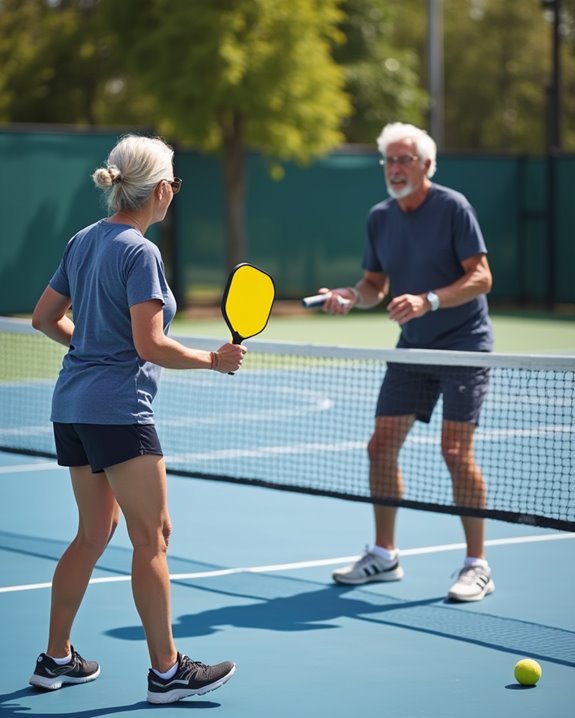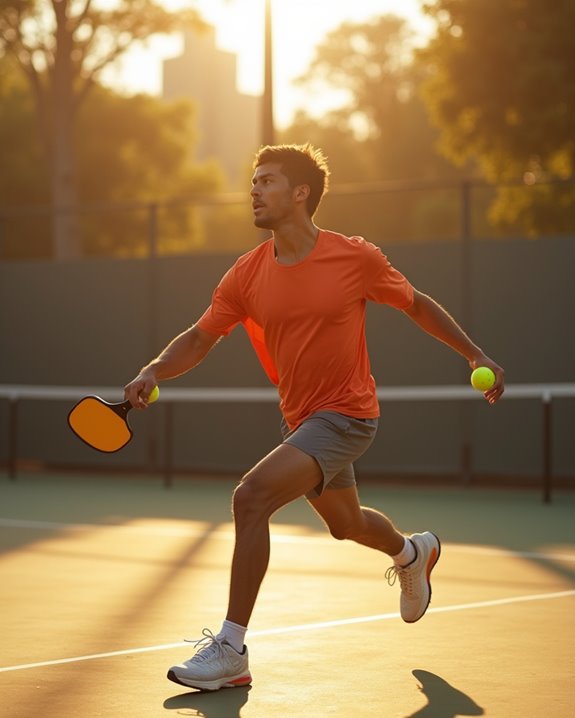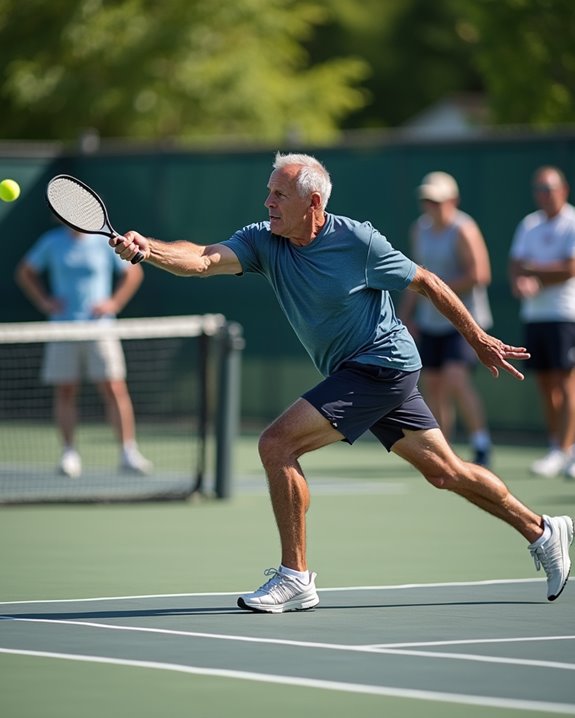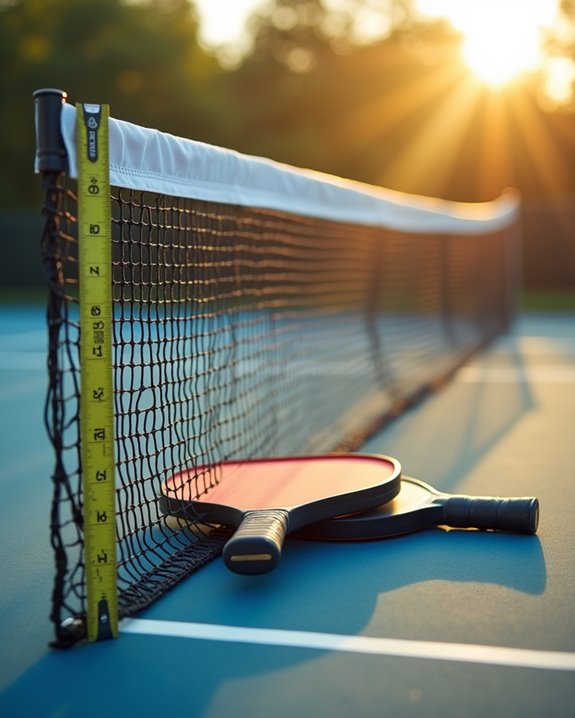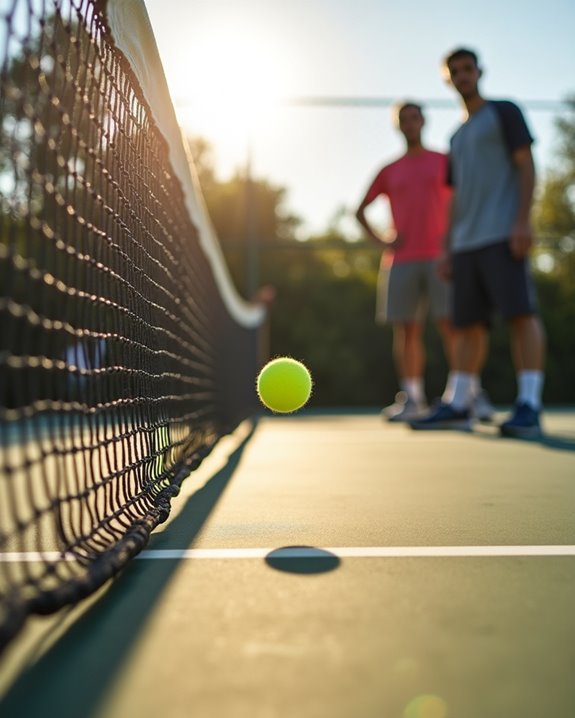Pickleball is played on a 20′ x 44′ court with a paddle and plastic ball. You’ll serve underhand diagonally across the net, following the two-bounce rule—meaning the ball must bounce once on each side before volleys are allowed. The “kitchen” (7-foot non-volley zone near the net) is off-limits for volleys. Only the serving team scores points, and games typically go to 11 points. Master these basics, and you’ll be rallying with confidence in no time.
Key Takeaways
- Pickleball requires a specialized court with a 7-foot non-volley zone, a 34-36 inch high net, paddles, and plastic balls.
- Serving is underhand and diagonal, starting from the right-hand court in doubles play.
- The two-bounce rule requires the ball to bounce once on each side before players can volley.
- Only the serving team can score points, with games typically played to 11 points with a 2-point lead.
- When announcing scores, state serving team’s score, receiving team’s score, and server number (example: “4-2-1”).
8 Second-Level Headings for “How To Play Pickleball For Beginners”
When you’re just starting your pickleball journey, breaking down the learning process into digestible sections makes mastering this addictive sport much easier. Your beginner’s guide should simmer with these essential headings:
- Court Layout & Equipment Essentials
- Mastering the Underhand Serve
- Understanding the Two-Bounce Rule
- Kitchen Line Strategy: Stay Out or Engage
- Scoring System & Rotation Basics
- Doubles Communication: Be a Great Team Player
- Rally Techniques: Dinks, Drives & Lobs
Each section will help you fold in fundamental skills one by one. Like learning to sauté before attempting a soufflé, you’ll need to perfect your serve before worrying about advanced strategies. The rules might seem like a complex recipe at first, but once broken down, you’ll be serving up competitive matches in no time!
Essential Equipment to Get Started
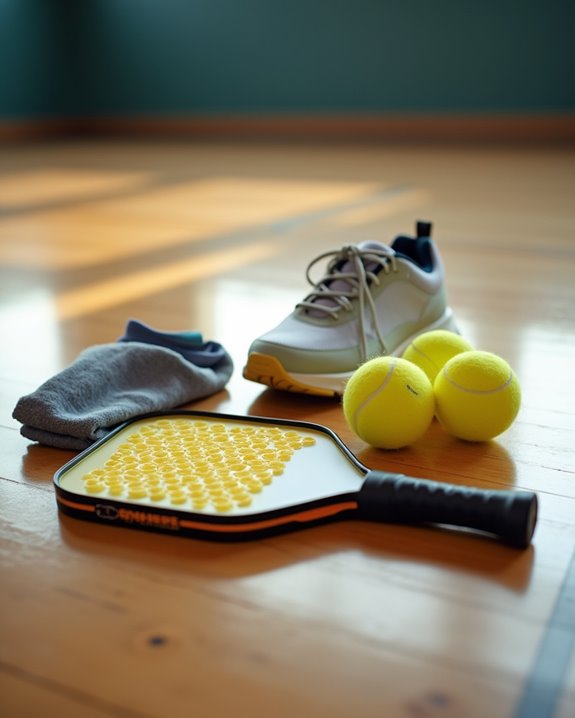
Now that you’ve got the bigger picture of pickleball fundamentals, it’s time to gather your ingredients for this addictive sport!
You’ll need a pickleball paddle (the primary utensil in your pickleball kitchen) that matches your playing style—heavier for power or lighter for control. Pair this with a lightweight plastic ball with holes, available in indoor or outdoor varieties depending on your playing area.
The court dimensions require a 20×44-foot space with a net measuring 36 inches at sidelines and 34 inches in the center. If you’re setting up your own court, a portable pickleball net is essential equipment for proper gameplay. Look for models that offer quick assembly to make your setup process smoother.
Don’t forget your comfortable sports apparel and non-marking athletic shoes—think of them as your chef’s uniform, providing the support and traction you’ll need to move freely around the court!
Understanding the Court Layout and Dimensions
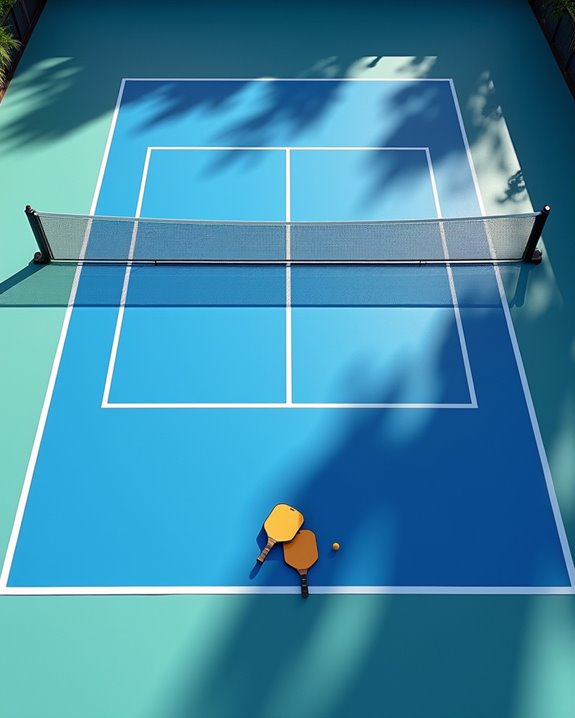
The pickleball court serves as your culinary canvas where all the action happens! At 20 feet wide by 44 feet long, it’s perfectly portioned like a well-balanced recipe—identical to a badminton court’s dimensions.
You’ll notice the net simmers at 36 inches on the sides while dipping slightly to 34 inches in the center. The most critical ingredient is the “kitchen” or non-volley zone, extending 7 feet from the net where you can’t volley the ball—think of it as a no-frying zone!
The court is bisected by a centerline that separates service areas, creating four equal quadrants to serve from. Your playing boundaries are clearly marked: sidelines, baseline at the back, and that all-important kitchen line that players must respect to avoid cooking up faults.
The Fundamental Rules Every Player Should Know
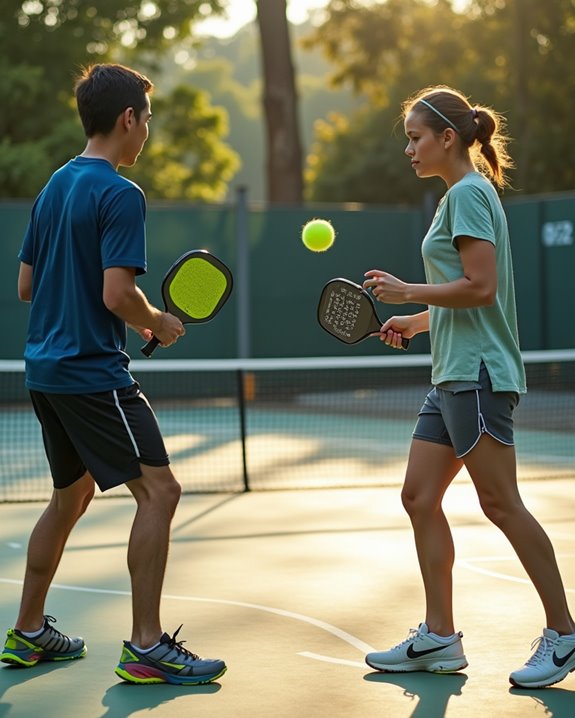
With your court knowledge simmering nicely, let’s fold in the rules that’ll transform you from kitchen novice to pickleball chef!
First, every point begins with an underhand serve diagonally across court. Only the serving team can score points, so defense is as essential as a well-reduced sauce! The two-bounce rule is your foundation—after the serve, the ball must bounce once on each side before players can volley. Think of it as resting your dough before baking. Additionally, it’s important to know that all nets meet regulation size specifications, ensuring a fair playing field for all participants.
Mastering the Two-Bounce Rule

Although it sounds simple on paper, the two-bounce rule serves as the secret ingredient in pickleball’s recipe for balanced gameplay. When you play pickleball singles or doubles, here’s what you need to remember: after the serve, the receiving team must let the ball bounce once before returning it. Then, the serving team must also let the ball bounce on their side.
A fault occurs if you volley the ball before these two bounces happen. Think of this rule as the “prep time” before the real cooking begins! You’ll want to position yourself near the baseline initially, simmering with anticipation. Only after both required bounces can you move forward to attack. This creates the perfect blend of defensive and strategic play, allowing rallies to develop like a well-crafted meal.
Proper Serving Techniques and Requirements
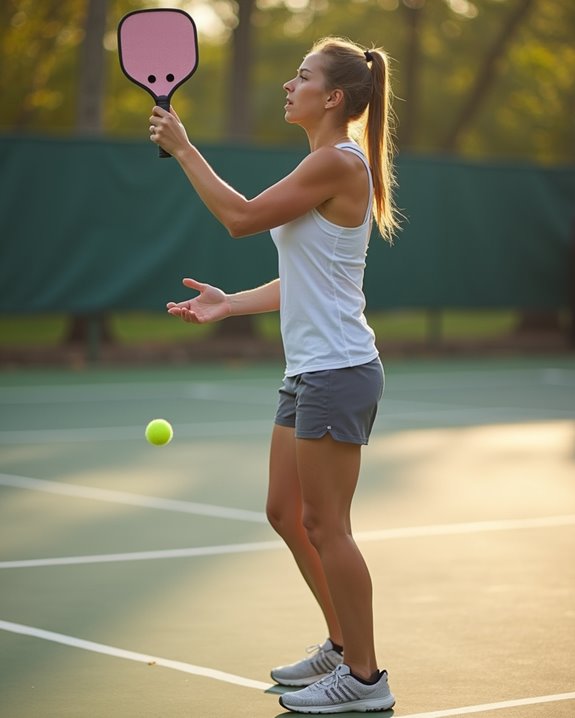
Serving in pickleball represents your prime opportunity to set the table for success right from the start! The serve must be executed with an underhand stroke, keeping your paddle below waist level—think of folding ingredients gently rather than vigorously whisking. You get only one serve per rotation, so make it count!
The server must position themselves behind the baseline and aim diagonally opposite into your opponent’s service court. Your serve needs to clear the kitchen (non-volley zone) completely—imagine launching the ball over a 7-foot obstacle course before it lands in the proper zone. A fault is committed if your serve doesn’t cross this area or if your paddle rises above your wrist during contact. For doubles, remember that the first serve always starts from the right-hand court.
The Kitchen Zone: What You Can and Cannot Do
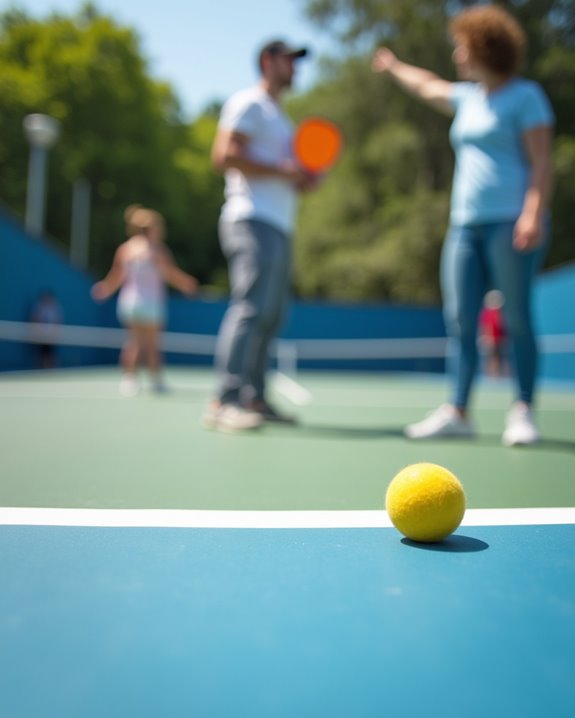
Just as a chef’s mastery of the kitchen determines culinary success, your understanding of pickleball’s “kitchen zone” will make or break your game! This savory 7-foot area extending from the net on both sides is also called the non-volley zone for good reason.
You cannot volley (hit the ball before it bounces) while standing in the kitchen zone. Doing so results in a fault—like overcooking a perfect soufflé! You’ll lose the rally instantly. However, you can enter the kitchen to return a bounced ball, but must exit immediately afterward.
Master the art of “dinks”—gentle, low shots that land in your opponent’s kitchen. These delicate shots, like a perfectly seasoned dish, keep players at the net and create opportunities for winning pickleball strategies!
Scoring System and How to Win
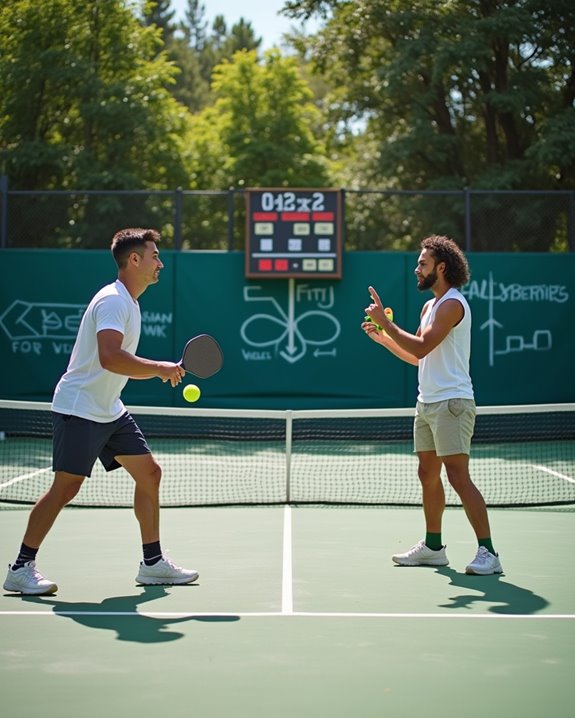
While mastering the kitchen zone adds flavor to your gameplay, understanding pickleball’s unique scoring system is the secret ingredient to competitive success!
In pickleball, only the serving team can score points. When it’s your turn to serve in pickleball, you’ll announce three numbers: serving team’s score, opposing team’s score, and server number (1 or 2). For example, “4-2-1” means the first server of the serving team has 4 points while the receiving team has 2.
The first team to reach 11 points (with a 2-point lead) wins! The server continues serving until a fault occurs, sending the ball in play to the other side. Most recreational games simmer to completion at 11 points, though tournament play might require you to cook up 15 or 21 points to claim victory.
Frequently Asked Questions
What Are the 5 Rules for Pickleball?
Think you’re ready to whack some wiffle balls? Remember: scoring basics (play to 11), serve techniques (underhand only), fault rules (kitchen no-no’s), the two-bounce rule (patience, grasshopper), and staying out of the non-volley zone when volleying.
How to Play Pickleball Step by Step?
To play pickleball, get your equipment, understand court dimensions, learn the scoring system, master basic techniques and serving strategies. Practice footwork fundamentals, follow game etiquette, develop doubles tactics, and avoid common beginner mistakes through regular drills.
What Is the Golden Rule Pickleball for Beginners?
While you might think pickleball is complicated, the golden rule is simple: don’t volley in the kitchen (non-volley zone). This court positioning strategy prevents faults and promotes player etiquette during rallies. Practice drills help reinforce this fundamental concept.
Can I Learn Pickleball on My Own?
Yes, you can learn pickleball through self-teaching techniques and solo practice. Utilize online resources and instructional videos, then visit local clubs to find training partners. Focus on equipment essentials, skill development, playing strategies and avoiding common mistakes.

